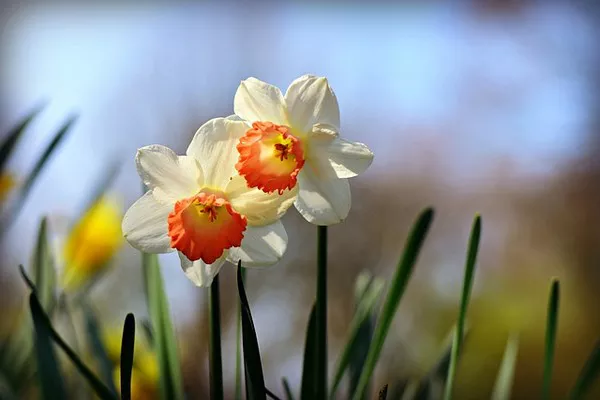Daffodils, with their vibrant hues and graceful appearance, have long captivated the hearts of both seasoned gardeners and casual observers alike. Belonging to the genus Narcissus, these exquisite flowers are renowned for their trumpet-shaped corona and radiant petals, heralding the arrival of spring with their cheerful presence. In this comprehensive article, we delve into the fascinating world of daffodils, exploring their taxonomy, anatomy, cultivation, symbolism, and much more.
Taxonomy and Classification
Daffodils belong to the family Amaryllidaceae, which encompasses a diverse array of bulbous plants. Within the genus Narcissus, there are over 50 species and thousands of cultivated varieties, each possessing its own unique characteristics and charm. Taxonomically, daffodils are further classified into divisions based on their physical attributes, including the size and shape of the flowers, as well as the arrangement of the petals and corona. These divisions aid gardeners and enthusiasts in selecting the most suitable varieties for their gardens or floral arrangements.
Anatomy of Daffodils
A closer examination of a daffodil reveals a remarkable fusion of botanical elements, each contributing to its overall allure. The flower typically consists of six petal-like tepals arranged in a whorl, with a central trumpet-shaped corona extending from the center. The tepals, which encompass three outer petals and three inner sepals, come in a myriad of colors ranging from pristine white and sunny yellow to vibrant orange and delicate pink. The corona, often contrasting in color with the tepals, serves as a focal point, drawing the eye towards its intricate details and subtle nuances.
Cultivation and Care
Daffodils are relatively easy to cultivate, making them popular choices for gardens, landscapes, and containers. These resilient bulbs thrive in well-drained soil with ample sunlight, although certain species and varieties may exhibit specific preferences regarding moisture levels and soil composition. Planting depth, spacing, and timing are crucial factors to consider when establishing daffodil bulbs, as they directly influence growth and flowering. With proper care and maintenance, daffodils can naturalize and multiply over time, forming enchanting drifts of blossoms that herald the arrival of spring.
Propagation Techniques
Propagation of daffodils can be achieved through various methods, including division of bulbs, offsets, and seed propagation. Dividing established clumps of bulbs every few years not only promotes healthier growth but also allows for the expansion of daffodil colonies within the garden. Offsets, also known as bulbils or daughter bulbs, develop alongside the parent bulb and can be carefully separated and replanted to propagate new plants. While seed propagation is less common due to the time-consuming nature of the process, it offers an opportunity to create novel hybrids and explore the genetic diversity of daffodils.
Symbolism and Cultural Significance
Throughout history, daffodils have held symbolic significance in various cultures and traditions, often representing themes of renewal, resilience, and hope. In literature and art, these enchanting flowers have been celebrated for their ephemeral beauty and enduring allure, inspiring poets, painters, and storytellers alike. In the language of flowers, daffodils convey messages of rebirth and optimism, making them popular choices for special occasions such as weddings, birthdays, and religious ceremonies. Additionally, daffodils feature prominently in folklore and mythology, where they are associated with tales of love, longing, and transformation.
Notable Varieties
Within the vast and diverse world of daffodils, several notable varieties stand out for their exceptional beauty, fragrance, or historical significance. The classic ‘King Alfred’ daffodil, with its large golden-yellow blooms and sturdy stems, remains a perennial favorite among gardeners and enthusiasts. ‘Ice Follies’ dazzles with its elegant white petals and pale yellow corona, while ‘Tête-à-Tête’ captivates with its miniature stature and abundant clusters of cheerful blooms. Other noteworthy varieties include ‘Pink Charm,’ ‘Jetfire,’ ‘Mount Hood,’ and ‘Thalia,’ each offering its own unique charm and appeal.
Pest and Disease Management
Despite their resilience, daffodils are susceptible to certain pests and diseases that can hinder their growth and flowering. Common pests such as narcissus bulb fly, thrips, and slugs may feed on bulbs, foliage, or flowers, causing damage and reducing overall vigor. Additionally, fungal diseases such as basal rot and narcissus yellow stripe virus can pose significant threats to daffodil health if left unchecked. Implementing proper cultural practices, such as planting in well-drained soil and avoiding overcrowding, can help mitigate these risks and promote the overall well-being of daffodil plants.
Environmental Impact and Conservation
As advocates for biodiversity and environmental stewardship, it is essential to consider the ecological impact of cultivating daffodils and other ornamental plants. While daffodils themselves are not considered invasive in most regions, improper disposal of bulbs or plant material can potentially introduce non-native species to natural habitats, disrupting delicate ecosystems and displacing native flora. Additionally, indiscriminate use of pesticides and fertilizers can have detrimental effects on soil health and beneficial insects, further emphasizing the importance of adopting sustainable gardening practices and supporting conservation efforts.
Conclusion
In conclusion, daffodils epitomize the beauty and resilience of spring, captivating hearts and minds with their exquisite blooms and timeless elegance. From their taxonomy and anatomy to cultivation techniques and cultural significance, daffodils continue to inspire and enchant people around the world, bridging the gap between nature and culture in profound and meaningful ways. As stewards of the environment, it is incumbent upon us to appreciate, preserve, and celebrate the splendor of daffodils for generations to come.


